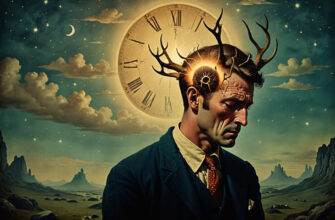Injury dreams can shake you up, but they rarely stick to just fears of bruises or broken bones. Instead, they often unlock hidden emotional or spiritual layers that your waking mind might be skimming over. Have you ever woken from such a dream feeling raw, confused, or strangely aware of an ache you didn’t know you had? Those visions tap into where you might be feeling vulnerable or carrying hidden wounds—things you’ve shoved down or stories you haven’t quite untangled. The body in these dreams becomes less about physical damage and more about what’s happening inside your heart, mind, or lineage. Often, these dreams point toward places where you feel powerless or stuck, nudging you to acknowledge or even heal what’s unsettled beneath the surface.
- What Injury Dreams Reveal Beyond Physical Harm
- Exploring Vulnerability and Unhealed Wounds Through Dreams
- How Powerlessness and Feeling Stuck Manifest Symbolically
- The Body as a Messenger: Interpreting Injury Locations as Unique Emotional or Ancestral Stories
- Recognizing Injury Dreams as Invitations Toward Healing and Transformation
- Reflection Questions to Connect Personal Feelings With Dream Imagery
- Common Injury Sites in Dreams and Their Emotional Significance
- Injuries to the Head: Conflicts of Identity and Mental Overwhelm
- Heart or Chest Injuries: Matters of Love, Trust, and Emotional Trauma
- Arms and Hands: Issues of Control, Creativity, and Communication
- Legs and Feet: Feelings of Instability, Stagnation, or Movement Blockages
- Eyes and Face: Perception, Vulnerability, and Self-Acceptance
- Injury on Others in Dreams: Reflecting Relational Dynamics and Empathy
- How Ancestral and Intergenerational Scars Can Appear in Body-Focused Dream Imagery
- Paying Attention to Suppressed Emotions: Anger, Grief, or Shame Hidden Beneath the Surface
What Injury Dreams Reveal Beyond Physical Harm
When your mind conjures an injury scene while you sleep, it’s rarely just about the body. Instead, consider the injury as a signpost, highlighting parts of your emotional or spiritual world that feel exposed or fragile. It might be revealing unhealed traumas, moments when your confidence took a hit, or experiences where you felt stripped of control. This kind of dream tends to surface when something in life has unsettled your sense of safety or belonging, whether recent or buried in the past.
Take, for example, someone dreaming about a broken arm. On a literal level, it’s an injury—but underneath, it can symbolize a fear of being unable to protect or support loved ones, or of losing creative power in a project or relationship. Injury dreams don’t just replay old wounds but bring awareness to places where healing is possible.
Exploring Vulnerability and Unhealed Wounds Through Dreams
Vulnerability isn’t often comfortable in waking life, so injury dreams offer a kind of safe space to explore it. The parts of your soul that feel bruised or tender tend to surface here, sometimes screaming for attention. These dreams call out emotional truths you might be shielding yourself from—for instance, unspoken grief, chronic self-doubt, or the sting of past betrayals. They act like emotional radar, zeroing in on wounds that haven’t fully healed or have been forgotten but still influence how you move through your day.
It’s worth remembering the way these dreams sometimes feel like a rehearsal or practice round. By revisiting painful moments in symbolic form, your subconscious creates an opportunity to face and process them without the immediate edges of real-life pain.
How Powerlessness and Feeling Stuck Manifest Symbolically
Dream injuries often show up in places that symbolize areas of life where you feel stuck, powerless, or blocked—whether it’s a stuck career path, a trapped relationship, or internal resistance to change. You might see yourself breaking a leg in the dream, which signals hesitation or fear around moving forward. Or it could be your hands, representing a struggle with action or expression.
This symbolic language offers clues about where you might be stuck and offers a way to gently confront what’s holding you back. A dream featuring immobilizing pain nudges you to look closer at what’s freezing your advancement and what emotional safety you might need to reclaim your power.
The Body as a Messenger: Interpreting Injury Locations as Unique Emotional or Ancestral Stories
The exact spot of injury can feel like a secret code from your unconscious, carrying distinct messages tied to emotional, social, or ancestral layers. Different parts of the body hold different stories:
| Injury Location | Emotional or Ancestral Meaning |
|---|---|
| Head or Face | Identity conflicts, mental overwhelm, or self-perception struggles |
| Heart or Chest | Love wounds, trust issues, emotional trauma |
| Arms or Hands | Questions of control, creativity, and connection to others |
| Legs or Feet | Feelings of stagnation, movement blocked, or instability |
| Abdomen or Gut | Deep fears, grief, shame stored in the body |
Sometimes these injuries hint at stories inherited from ancestors—pain passed silently through generations. Recognizing this can open pathways toward not just personal healing but also ancestral reckoning.
Recognizing Injury Dreams as Invitations Toward Healing and Transformation
Instead of just scary or painful omens, injury dreams often come bearing gifts disguised as wounds. They invite reflection, asking you to tend to old hurts and reclaim your power through healing work. The shock of the injury in the dream can be a wake-up call—a cosmic nudge to be curious about what parts of your life or history could use compassion and care. These dreams might also help prepare you emotionally for real-life healing journeys or shifts, especially during intense cosmic weather.
Viewing these dreams through a queer and feminist lens offers radical space to honor vulnerability as strength and brokenness as a step toward wholeness. These injuries become portals, transforming pain into self-acceptance and liberation.
Reflection Questions to Connect Personal Feelings With Dream Imagery
- Where in your body did the injury appear in the dream, and what emotions come up when you think about that area?
- Who else was there? Did they hurt, help, or witness you? What does that say about your relationships?
- How did the wound look—fresh, bleeding, scarred, or healing? What might that stage represent in your life?
- What feelings did the dream stir—shame, relief, fear, or numbness? Can those feelings point to something your waking mind is avoiding?
- Are there recurring themes or injuries that feel connected to past traumas or ancestral patterns?
These questions encourage using injury dreams as mirrors reflecting inner landscapes, inviting you to meet your deeper self with curiosity and tenderness. Self-knowledge is a form of liberation, and injury dreams might just be the doorway standing open. You were born for this.
Common Injury Sites in Dreams and Their Emotional Significance
Have you ever woken up unsettled after dreaming about getting hurt? Those injury scenes aren’t just random freak-outs by your brain—they often nudge you toward feelings that are simmering just below the surface.
Injuries to the Head: Conflicts of Identity and Mental Overwhelm
The head represents your sense of self, identity, and mental clarity. Dreaming about a head injury might be your unconscious revealing confusion, doubt, or an internal clash about who you are. It’s like your brain is saying, “Hey, your thoughts feel tangled, or your identity feels threatened.” Maybe you’re overwhelmed by societal expectations or feeling fragmented in how you present yourself.
Heart or Chest Injuries: Matters of Love, Trust, and Emotional Trauma
Pain in the chest or heart area taps deep into emotional vulnerability. These dreams frequently raise issues around broken trust, heartbreak, or the ache from past wounds that still throb under the surface. A chest injury in a dream can point toward grief that hasn’t fully settled or courage being tested by real-life betrayals.
Arms and Hands: Issues of Control, Creativity, and Communication
Hands and arms are the tools you use to express yourself and shape your world. An injury here can highlight where you feel powerless or creatively stuck. Maybe you’re struggling to get a message across or uncertain about your ability to reach for what you want. Those dreams might ask you to consider where you’ve put down your power or why you hold back.
Legs and Feet: Feelings of Instability, Stagnation, or Movement Blockages
When legs or feet show up injured, it’s often about feeling stuck, unsure, or unsteady in life’s journey. These dreams surface when forward movement seems blocked—be it a project, a relationship, or a personal goal. Maybe it’s fear of change or uncertainty about your path that causes you to stumble even in sleep.
Eyes and Face: Perception, Vulnerability, and Self-Acceptance
Injuries to the face or eyes carry weighty messages about how you see the world and, crucially, how you believe the world sees you. Damage here can point to feelings of shame, fear of being seen or judged, or struggles with self-acceptance. These dreams confront the tender point where personal truth and vulnerability intersect.
Injury on Others in Dreams: Reflecting Relational Dynamics and Empathy
Seeing someone else injured in a dream often mirrors your emotional state or relationships. It could be a reflection of your empathy—perhaps you’re absorbing someone else’s pain or sensing trouble in their life.
For example, dreaming of a close friend hurt might reveal anxiety about their wellbeing or a subconscious call to support them.
Alternatively, it can highlight unresolved tensions or fears about dependency, protection, or guilt. If a dream keeps showing injury on others, it could be time to explore these relational undercurrents and what they reveal about your emotional ecosystem.
How Ancestral and Intergenerational Scars Can Appear in Body-Focused Dream Imagery
Not all wounds come from your personal story. Sometimes, dreams show injuries that feel older than you—ancestral pains, passed down through generations in stories, behaviors, or silence.
Those bruises on your dream-body might carry echoes of family trauma, colonization, racism, or systemic oppression that went unhealed but lives on in your cells.
Dreaming of these injuries asks you to consider your lineage and how ancestral grief or shame shapes your emotional landscape. These images are invitations to break painful cycles, reclaim narrative power, and bring light to hidden histories within your own body and psyche.
Paying Attention to Suppressed Emotions: Anger, Grief, or Shame Hidden Beneath the Surface
Injury dreams often harbor emotions we shove away during the day—anger too risky to express, grief that feels too raw, or shame too deep to face openly.
Think of these dreams as the body’s cracked open wound where those feelings seep out, refusing to be ignored.
- Anger: Injuries connected to rage might appear as bruises or burns, hinting at frustration kept under wraps or injustice endured.
- Grief: Dreams featuring bleeding or aching injuries can symbolize loss and mourning demanding recognition.
- Shame: Hidden cuts or scars may relate to feelings of unworthiness, social rejection, or cultural stigma.
The dream’s injury acts as a messenger, urging attention and healing. Giving space to these suppressed emotions—whether by journaling, therapy, or creative outlets—allows those hidden parts to surface safely and eventually soften.








